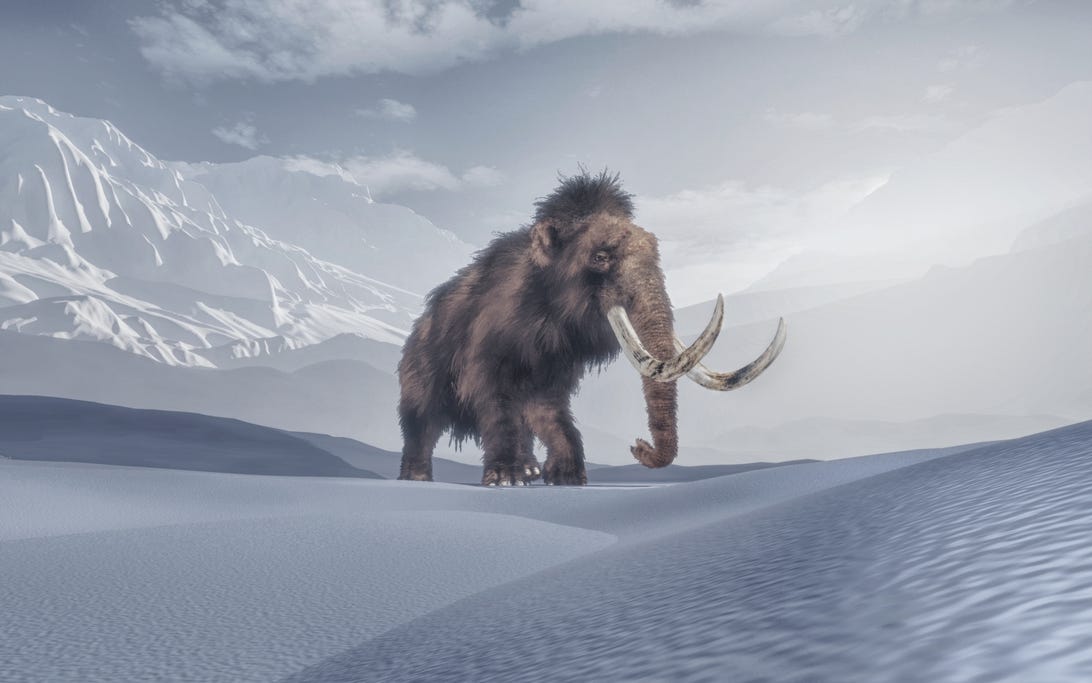
Colossal hopes to help bring the woolly mammoth back from extinction.
Getty Images/OrlaYou've heard of startups building computer chips, delivery drones and video chat apps. One called Colossal has a different goal: bring the woolly mammoth back from extinction by 2027 using CRISPR, a revolutionary gene-editing technology.
The plan isn't to re-create true woolly mammoths, but rather to bring their cold-adapted genetic traits, which include small ears and more body fat, to their elephant cousins, creating a hybrid that can wander the tundra where mammoths haven't been seen for 10,000 years. Colossal's co-founders are Chief Executive Ben Lamm, who started five companies before this, and George Church, a Harvard Medical School professor with deep CRISPR expertise.
"Our true North Star is a successful restoration of the woolly mammoth, but also its successful rewilding into interbreeding herds in the Arctic," Lamm said. "We're now focusing on having our first calves in the next four to six years."
It's an interesting illustration of an imperative sweeping the tech world: Don't just make money, help the planet, too. Tesla's mission is to electrify transport to get rid of fossil fuels that hurt Earth. Bolt Threads wants to replace leather with a fungal fiber-based equivalent that's easier on the environment than animal agriculture. Colossal hopes its work will draw attention to biodiversity problems and ultimately help fix them.
Colossal has raised $15 million so far, led by investment firm Tulco. The startup's 19 employees work at its Dallas headquarters and in offices in Boston and Austin, Texas, and it's using its funds to hire more.
Artificial wombs and other technology spinoffs
Church said he expects spinoffs from the company's biotechnology and genetics work.
"The pipeline of large scale genome engineering techniques can be applied to many other applications beyond de-extinction, and therefore [are] most promising for commercialization," he said.
One technology ripe for commercialization is multiplex genome engineering, a technique Church helped develop that speeds genetic editing by making multiple changes to DNA at once.
Colossal also hopes to develop artificial wombs to grow its mammoth embryos. Just growing 10 woolly mammoths with surrogate elephant mothers isn't enough to get to the large-scale herds the company envisions.
At the foundation of Colossal's work is CRISPR. This technology, adapted from a method bacteria evolved to identify attacking viruses and chop up their DNA, is now a mainstay of genetic engineering, and Church has been involved since CRISPR's earliest days.
There are other ways Colossal hopes to help. Its gene editing technology could artificially add genetic diversity to species with only small surviving populations, Lamm said.
Jurassic Park-style tourism? Nope
Selling or licensing spinoff technology is a somewhat indirect way of running a business. A more direct option is selling tickets to tourists. After all, humans already pay lots of money to see charismatic megafauna like lions, elephants and giraffes on African safaris. Seeing a creature that's been gone for 10,000 years could add to the excitement.
But that's not Colossal's game plan. "Our focus is on species preservation and protection of biodiversity right now, not in putting them in zoos," Lamm said. By re-creating woolly mammoths, Colossal can preserve the genetic legacy of Asian elephants that now are endangered.
Another candidate species Colossal wants to re-create is the woolly rhinoceros, a relative to the critically endangered Sumatran rhino.
Although Colossal doesn't plan to build a tourist destination, it does have a woolly mammoth rewilding site in mind that sounds awfully close to Jurassic Park: Pleistocene Park. This area of about 60 square miles in northern Russia, named after the geologic period that ended with the last ice age, is where researchers Sergey and Nikita Zimov are trying to test their theories about the ecological and climatic effects of rewilding.
One Zimov idea is that woolly mammoths will trample snow and knock down trees. That, in turn, will restore grasslands that reflect more of the sun's warming rays and eliminate insulating snow and forests so the ground cools more. And that means the ground will stay frozen instead of releasing its current store of carbon dioxide and methane greenhouse gases. About 260 billion to 300 billion metric tons of carbon could be released from thawing permafrost by 2300, scientists calculate, exacerbating the weather extremes and other problems caused by climate change.
Is species de-extinction a good idea?
There's an appeal to the idea of de-extinction. Humans have dramatically altered the planet, and the United Nations estimates we threaten 1 million species with extinction as a result.
Colossal hopes its work will raise more attention to the biodiversity collapse. And it also plans to create detailed genetic descriptions of many endangered species "so we have the recipe if that species does go extinct," Lamm said.
But is that really the best use of our resources to help the planet? No, some researchers believe.
Resurrecting species could have some benefits, but money would be better spent protecting ones that are still around, a group of biologists argued in one paper published in Nature Ecology & Evolution. "Potential sacrifices in conservation of extant species should be a crucial consideration in deciding whether to invest in de-extinction or focus our efforts on extant species," the researchers wrote.
But this isn't government money Colossal is talking about, and Lamm argues that his startup's work complements other conservation efforts. And, he argues, startups can move faster than government-funded work.
In a world dominated by climate crisis headlines, a startup that makes money with an ecosystem-improvement focus has special appeal. One investor, Zack Lynch of Jazz Venture Partners, is excited by software, hardware and biotech he expects Colossal will create.
At the same time, "these breakthroughs will help address issues such as land degradation, animal pollinator loss and other negative biodiversity trends," Lynch said. Given how big our environmental problems are, you can see why an investor might be interested.
https://news.google.com/__i/rss/rd/articles/CBMiXGh0dHBzOi8vd3d3LmNuZXQuY29tL25ld3Mvd29vbGx5LW1hbW1vdGhzLWNvdWxkLXdhbGstZWFydGgtYWdhaW4taWYtY3Jpc3ByLXN0YXJ0dXAtc3VjY2VlZHMv0gFnaHR0cHM6Ly93d3cuY25ldC5jb20vZ29vZ2xlLWFtcC9uZXdzL3dvb2xseS1tYW1tb3Rocy1jb3VsZC13YWxrLWVhcnRoLWFnYWluLWlmLWNyaXNwci1zdGFydHVwLXN1Y2NlZWRzLw?oc=5
2021-09-15 17:54:00Z
52781878517657
Tidak ada komentar:
Posting Komentar